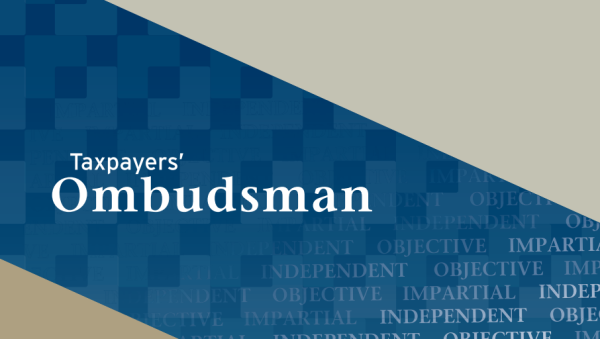Taxpayers’ Ombudsperson: What is it and When Can You Use It?
** Note: In 2020, the CRA updated the term “Ombudsman” to “Ombudsperson”. **
Learn more about what the Taxpayers’ Ombudsperson can do for you.
We have previously written about the process of filing a service-related complaint with the Canada Revenue Agency (CRA). However, there are instances where the CRA’s service complaint process does not satisfy a taxpayer’s concerns regarding the timeliness, consistency, and professionalism of the service provided.
In these cases, it may be beneficial for the taxpayer to escalate the complaint to the Office of the Taxpayers’ Ombudsperson (OTO). This post explains exactly what the Taxpayers’ Ombudsperson can do for you and how to file a complaint with them.
Mandate of the Taxpayers’ Ombudsperson
Overview
The OTO provides an “independent and impartial review of unresolved complaints from taxpayers about the service or treatment they have received from the CRA.” 1
The OTO’s investigations are guided by their following stated principles of independence, impartiality, fairness and confidentiality: 2
Independence
- The Ombudsperson operates at arm’s length from the CRA.
Impartiality
- The Ombudsperson is neither an advocate for the taxpayer, nor a defender of the CRA.
- The Ombudsperson considers the position and perspective of both the taxpayer and the CRA when examining a complaint or issue.
Fairness
- The Ombudsperson acts with equity and justice.
Confidentiality
- The Ombudsperson holds all communications with those seeking assistance in strict confidence and does not disclose confidential communications unless given permission to do so.
The Ombudsperson and the Taxpayers’ Bill of Rights
The CRA has a Taxpayer Bill of Rights that “defines 16 rights and builds upon the CRA’s corporate values of professionalism, respect, integrity, and cooperation.” 3
Of the 16 total rights, there are 8 service-related rights relevant to complaints filed with the OTO: 4
- Rule 5: the right to be treated professionally, courteously, and fairly;
- Rule 6: the right to complete, accurate, clear, and timely information from the CRA;
- Rule 9: the right to lodge a service complaint and to be provided with an explanation of the CRA findings;
- Rule 10: the right to have the costs of compliance taken into account when tax legislation is administered;
- Rule 11: the right to expect the CRA to be accountable;
- Rule 13: the right to expect the CRA to publish service standards and report annually;
- Rule 14: the right to expect the CRA to warn you about questionable tax schemes in a timely manner;
- Rule 15: the right to be represented by a person of your choice.
When to Use the Taxpayers’ Ombudsperson
Eligible Complaints
As we noted in our article about CRA Service Complaints, these are in relation to treatment received from the CRA, and not the CRA’s overall assessment of the claim. Furthermore, escalating a complaint to the OTO should only occur if a taxpayer has already gone through the CRA’s complaint process and feels that their issue has not been properly resolved by the CRA or by the CRA complaints officer assigned to the file.
In some situations involving what the OTO refers to as “compelling circumstances” — i.e. recurring/systemic issues, unreasonable timeframes, etc.5
Examples of eligible complaints include: 6
- undue delays;
- poor or misleading information;
- staff behaviour; or
- mistakes, which could potentially result in a misunderstanding.
How to File a Complaint
There are three methods for submitting a complaint with the OTO: electronically, by mail, or by fax.7 Regardless of which format a taxpayer chooses, the complaint must contain the following information:
- Contact information
- Information about your complaint (including relevant documentation, such as correspondence with the CRA)
- Information about previous actions taken to resolve the complaint, i.e. filing a CRA service complaint
The OTO recommends that taxpayers ask for the identity of each and every CRA agent throughout the complaints process, including the agent’s name, employee number, and location. The OTO also recommends that taxpayers be clear with their complaint’s goals, whether they want an apology from a specific CRA agent, or simply want access to a service that they feel has been withheld from them.8
The Ombudsperson’s Complaint Process
Taxpayers can expect a four step process after filing a complaint with the OTO. Please note that the OTO does not have a processing time limit, and that processing times will vary on a case-by-case basis: 9
- Acknowledgement that the complaint has been received, including a reference number;
- Screening as to whether the complaint meets the qualifications for a service complaint;
- Review process where an examinations officer reviews all information associated with the complaint and keeps the taxpayer informed of any updates; and
- Conclusion where the officer sends an overview of recommendations and action items (i.e. offer an apology, review service standards, give further rationales for decisions, etc.) to the taxpayer and the CRA. The officer will follow up with the CRA regarding these recommendations.
Furthermore, taxpayers can also expect that the following high level of service standards will be met by their OTO examinations officer: 10
- acknowledges receipt of taxpayer contact and/or complaints within two business days – 100% of the time; and
- provides taxpayers with an update on their file every 15 business days – 100% of the time.
This article is based on Office of the Taxpayers’ Ombudsperson (OTO) policy documents available at the date of publication. Please consult the OTO website for the most recent versions of these documents.
Connect With Us!
Share your thoughts by commenting below or joining the conversation on our LinkedIn page, Facebook page, or via Twitter.


Comments are closed.